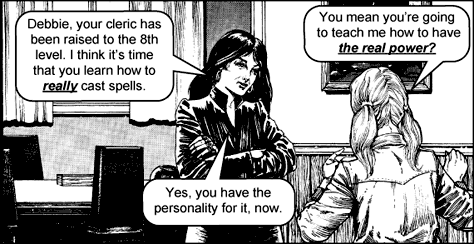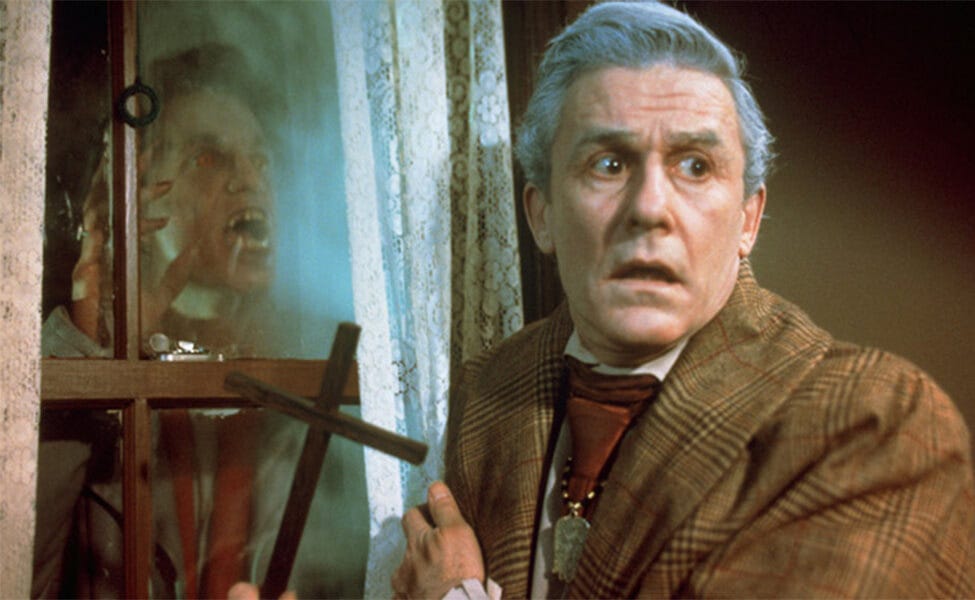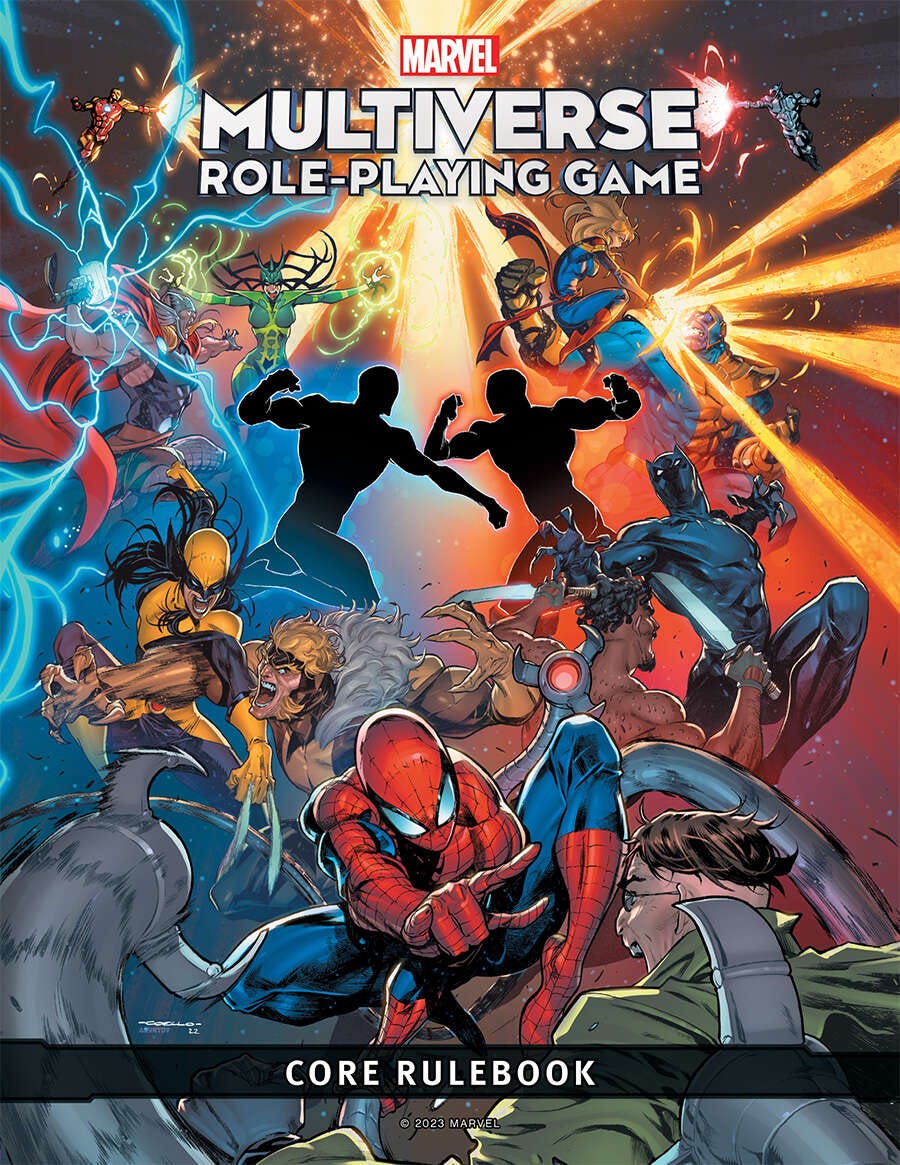Weekly Geekly Rundown for July 25, 2025
We Need More Horror/Genre Hosts
What do Horror Movie Hosts, Weather Reporters, and a strong sense of community have in common? Get a glimpse inside how my mind makes weird connections as I answer this very question.
One of the things I love about Boise, Idaho is that we have a number of locally owned radio stations that have hosts who participate actively in community events. Even our “big” network affiliate television stations make sure to have shows devoted entirely to promoting what is going on around the Treasure Valley. The other day I was listening to one of our local radio stations and there was an interview with board members of The History of Idaho Broadcasting Foundation. One of these board members talked about how important Marty Holtman had been to the Boise area. Marty Holtman was a longtime radio host and legendary television weatherman who died a little over a year ago.
I don’t know what it is about weather reporters, but few members of local news teams seem to connect with audiences in the same intimate way as the local meteorologist. It’s kind of funny that the news person who people think of as the most incorrect in their observations compared to the other journalists is the most beloved. People frequently complain that the weather reporter is an idiot when it does or doesn’t rain, or when it is hotter/cooler than expected. The reasons for this perception, and it’s more perception than reality, is two fold. The models that weather reporters use are among the “noisier” of statistical tools, at least outside of a five day or so window. More importantly though, people don’t understand probabilities very well so when a reporter says there’s a 50% chance of rain and it doesn’t rain they think the reporter got it wrong. This means that outside of Los Angeles, where David Lynch famously did radio weather reports and where you can pretty much just say it’s going to be sunny and you’ll be right most of the time, the job comes with a high degree of uncertainty.
Speaking of Los Angeles, I used to love watching Dallas Raines with his iconic “punch and point” delivery and Johnny Mountain with his great sense of humor when I lived in Tinseltown. I also loved how those names just shout “I report on the weather!” Dallas Raines? Are you kidding me?
While the current crop of Boise meteorologists don’t have names as colorful as Raines and Mountain, they are great at building connection with their audiences. Hector Mendoza brings a charming sense of whimsy to his weather reporting.
I originally thought that it would be impossible to replace Rachel Garceau, with her “dog walk conditions” addition to the report, on the morning show but Hector is fantastic. Garceau has since been rightly promoted to the evening team as the KTVB’s Chief Meteorologist, but her evening reports are more straight forward and less “Morning Zoo and Coffee” in feel. My hope is that she’ll push to add a little silliness to the eveneing reporting because she was a real pleasure to watch during KTVB’s “morning couch and coffee conversations.”
The only local television host I can think of who has historically connected with audiences better than the weather reporter is the local Weekend Horror Show host, and sadly these are a dying breed as on demand entertainment comes to dominate our home viewing. Marty Holtman, the legendary Boise weatherman was at one time Claude Gloom and hosted his own scary show.
Some local horror hosts like Svengoolie, Elvira, and Joe Bob Briggs have become national brands, but my personal favorite Bob Wilkins never did. Wilkins was more than just a horror host, he was a celebrator of all popular culture and his Captain Cosmic show that ran on Oakland’s KTVU exposed tons of young people to a wide variety of science fiction and fantasy content.
I remember fondly getting my Captain Cosmic Club Card and Decoder in the mail and eagerly awaiting using it for the first time. Like Ralphie in A Christmas Story, my excitement at the mystery message knew no bounds. Unlike Ralphie, when I decoded my first message my excitement remained. The first secret message I decoded was no mere advertisement for Ovaltine, no, no, no, Bob Wilkins, I mean Captain Cosmic, was a much savvier user of media than that. The message was an announcement that KTVU would soon be airing the classic 1961 fantasy/SciFi film Mysterious Island! This was no mere promotion for a mid tasting malted chocolate beverage, this was an announcement that a Ray Harryhausen film would be airing.
Now that was worthy of a secret message!
As VCR and the DVD rentals became more and more ubiquitous, the local channels acted as if need for these kinds of hosts had faded. After all, if you can watch whatever movies you want just by going to the video store, why should they waste the money on low viewer content? If you wanted to “discover” new shows and films, that could be done browsing the aisles. As streaming took over, this trend accelerated. Audiences didn’t “need” a host if they could find anything online.
Such a view is short sighted in my opinion. These hosts serve two overlapping purposes. The first is that they build a local community of fandom with a shared reference point. These hosts can sponsor local events where likeminded people can meet and share their love for genre entertainment without the crass commercialism of a larger convention. Sure, it’s also promoting the station and by proxy the ad revenue. I’m not saying it isn’t capitalist behavior, just that it’s not crass. It’s the same as the difference between the Ovaltine ad and the ad for Mysterious Island. Both are ads, but one is a better connection with fans.
The second purpose these hosts serve is to inform the audience of what is coming up and more importantly about the history of the genres they love. Sure, we can always Google information about Ray Harryhausen, but it’s better to learn about the famed special effects man and film director from someone who grew up loving his films and who wants to share that joy. That’s a gift. It’s why Turner Classic Movies has hosts and why The Criterion Channel has a magazine and frequently has featurettes and intros for the movies on the app. I find Criterion’s efforts informative, but a poor substitute for a figure like Robert Osbourne or even Ben Mankiewicz, Alicia Malone, and Eddie Muller.
Hosts matter and I miss the local host and wish we had one here in Boise. Thankfully, there are still some hosts and viewers can capture a bit of the magic by watching Svengoolie on MeTV or by subscribing to the Creature Features channel named after Bob Wilkins famous show. Vincent and Tangella try to build a sense of community, and Svengoolie does too, but it’s still not the local host who can (like Peter Vincent) rush to your neighborhood to help you battle the undead infestation next door. Only truly local host like Claude Gloom could do that.
The Lamentations of Luke Y. Thompson
For as long as I’ve known him, LYT has been one of the most professional and comprehensive journalists covering San Diego’s famous ComicCon. Unless some things change in the print media market, I win the lottery, or he gets enough paying subscribers at ill LYTeracy, it looks like this might be his last year attending and covering the event. As I mentioned, Luke’s coverage is comprehensive. He covers almost every aspect of the event with depth and knowledge and I think some of the brands who support the publications that no longer hire Luke will suffer for him not being there.
A great example of how this is true is Luke’s coverage of action figures at the convention. Given the connection between comic books, cartoons, and action figures, SDCC is a major announcement venue for action figure lines and while newsletters might reach a lot of the audience, a good critical article discussing releases tells us a lot more and Luke’s got a good overview on his site.
Of course, being a friend of Luke’s means that I get glimpses of things before his articles are published and he shared me what he called “The Most [Christian Lindke] toys ever.” Luke took a picture of an upcoming expansion from NECA for their Ben Cooper Costume Kids collection. It includes a trilogy of figures inspired by the LJN toy line for Dungeons & Dragons back in the day.
Let’s just say that Luke was right and these are in fact the most me toys ever. I cannot wait for these to come out and will be adding Strongheart and Warduke to the shelves as soon as possible. I’m not as keen on their Zarak, but that’s more because Ben Cooper didn’t make the face green like a proper Orc.

Luke also had the opportunity to cover a panel discussing the resurfacing of a remake of one of his favorite films of all time, The Toxic Avenger. It’s a genuine cult classic, unlike Working Girl which modern Vogue writers consider a cult classic. Working Girl made $63 million ($168 million today) on a $12 million budget ($32 million today), was nominated for three BAFTAs and six Oscars, and was directed by a top tier Hollywood Director (Mike Nichols). Working Girl is just a classic. It’s old, sure. As my daughters would say, “It’s from the Nineteen Hundreds.” Looks like the “grass touching” kids need to do today includes learning the difference between something that is still popular with future generations and a cult classic.
Let me set that aside to the side, and thank Courtney Howard for tweeting about it, and get back to The Toxic Avenger. It’s a true cult classic film. It was made for a microscopic budget of $500k (Troma Trivia) - $1 million (AFI) and opened on only 45 screens when it was released on April 4, 1986 (AFI it’s listed as April 11 on IMDBPro) though it had been screened at Cannes in 1984 as Toxic and at the American Film Market as Health Club in March of 1985. While producer Lloyed Kaufman has reported that the film grossed more than $15 million between its release and 1989, that was largely due to a growing cult fanbase keeping it alive, a strong enough fanbase to inspire a syndicated cartoon G-rated series called Toxic Crusaders, but I’d have to rely on David Perlmutter for any real details on the series.
Have you ever seen a Working Girl animated series in syndication? Comic Books? Video Games? That’s the difference between a regular classic (and Working Girl is not just a classic it is in my list of perfect films) and a cult classic. Troma Studios, the makers of The Toxic Avenger, have been hit or miss with my tastes. I really like Toxie and crew, though not as much as Luke I’m sure, but Tromeo and Juliet bored the crap out of me. While Troma films are designed to shock and push our boundaries, but I thought it felt forced. Kevin Vasquez is a big fan and I haven’t asked Luke, but I’d guess it’s in his wheelhouse.
Anyway…Luke’s discussion of the panel is a wonderful combination of journalism and personal essay.
James Maliszewski’s Grognardia blog was one of the weblogs that inspired me to start writing my own stuff. I’ve been a fan of James’ work for ages. I purchased his Thousand Suns role playing game and was a backer on his Dwimmermount setting (not one of the ones who harassed James into silence), so I’m very happy to see that he’s come over to Substack with theGrognardia Games Direct newsletter.
Matt Thompson has an interesting Critical Hit Parader this week that is a great demonstration of his mix of music, fiction, and games. This week he focuses on his favorite writer, and one of the favorite writers of the first girl I ever truly loved, Robert Anton Wilson. Matt covers Wilson’s musical influences and his influence on Steve Jackson Games’ Illuminati lines of role playing and card games. If you are a fan of conspiracies, the X-Files, or the Gravity Falls cartoon, I highly recommend the Illuminati game.
Taking a step away from pop culture and into my day jobs, Matt Grawitch has a very interesting entry in a recent The Eel-Filled Hovercraft discussing how the data we use can be influenced by who is asking and how they ask the questions. Dr. Grawitch teaches about decision sciences at Saint Louis University and often writes articles I find very interesting, especially when they discuss the limits of metrics.
One of the things that makes most social sciences so challenging is that the results of experiments or studies are often difficult to reproduce. This isn’t because the social sciences aren’t science, they are, rather it’s because though social sciences are science they struggle with instrumentalization of variables. While the Kilometer or Foot are both arbitrary measures, once they are established they are consistent over time. They are arbitrary, but largely objective after the fact.
In social sciences we have known phenomena, let’s say partisan identity since I study that, that are measured multiple ways and often inconsistently. Burden and Klofstad examined this in a 2005 article in Political Psychology where they changed the traditional party identity measure from who you “think” you fit with ideologically to who you “feel” you fit with ideologically and opened an entire new field of study regarding how to measure affective vs. cognitive partisanship.
The assertion that social sciences aren’t science frustrates me almost as much as when people say “the plural of anecdote ISN’T data.” Yes, yes it is. The plural of anecdote is, in fact, data. All data, whether measured data in Physics or survey data is a collection of anecdotes. Raymond Wolfinger, a leading figure in political science, discussed with his graduate students in 1969-1970 how data was the plural of anecdote and Nelson Polsby repeated this aphorism in his article on the contributions of Richard Fenno to Political Science. Fenno’s book Home Style is one of the most important books ever written on Members of Congress and it is “merely” case studies.
Good Game Lobby has an article on one of the most interesting video games I’ve seen in a while. Ruffy and the Riverside includes a combination of computer and hand drawn animation with some interesting mechanics to create what looks like a remarkable video game platformer.
I’m commenting on a couple of Dr. Rebekah King’s articles this week. The first was a celebration, with thank yous, of her one year anniversary on Substack. She’s proven that you can build community, and grow your audience, through the continued publication of consistent and quality content, even as more famous published authors move into this space.
My feelings on the recent increase of professional essayists into this space are complex. I welcome the poetry and insight of Sherman Alexie. We are both products of the Mountain West and I feel a deep connection to him because he reminds me of some of the closest friends I had in high school in Northern Nevada. Though he is an award winning and published author, and I imagine has a decent number of paid subscribers, he doesn’t tend to paywall his stuff. His art is there for the world and he’s happy to be, and deserves to be, paid for his work, but he doesn’t limit who can experience it. His participation in the community inspired me to buy his book The Absolutely True Diary of a Part-Time Indian. I’m not telling you to buy Sherman’s book…yes I am. It’s great. Go buy it.
Where Sherman has made me feel a part of a bigger community, authors like Nick Hornby mildly annoy me. He is one of my favorite writers in general. High Fidelity and About a Boy are on my list of perfect films and there are few authors who have two films on that list. Yet while he was writing his Substack, it was paywalled.
I don’t blame the individual authors for the paywalls in this case, rather the structure of Substack. There is currently no means for groups of authors to create “magazines” where we pay a single monthly subscription to gain access to 10 authors. I image there’s a market for that. Certainly, I’d like it. Substack really has become my replacement for publications in the vein of The Atlantic, Esquire, and New York Magazine. I love long form media, but as my aside above regarding Vogue cult films suggests, the best polymathic writers are not publishing as frequently in the premiere places anymore.
Dr. King may not be a polymath, but she is a deep expert and great writer and that’s why I “upgraded” to paid on her Substack even as I envy that her growth has been faster than my own, though it’s only a little envy.
As I have mentioned in every Jahrzeit post I publish on the anniversary of my mom’s death (October 7th), I am a person of faith. Though I publish a Jahrzeit essay, the religion I practice isn’t Judaism, it’s Roman Catholicism. While my religion is very specific, my faith is very ecumenical. I’m the kind of person who welcomes Missionaries of the Church of Jesus Christ of Latter Day Saints into my home for discussions of The Book of Mormon out of a genuine desire to share faith. My religion isn’t theirs, and I believe their religion to be in error, but I find that our faith often aligns. I only mention the LDS Church because the second woman I every really loved was and is a member of that Church and she still holds a special place in my heart (we are still friends). I could have mentioned many other religions, philosophies, and faith traditions. My friends range from Atheists to Zoroastrians. That might be an exaggeration, but only a slight one. I came to my faith in waves. First through the kindness of those with faith when I was very young, then through philosophy, and finally through a Pascalian Night of Fire. Faith is hope and I have a lot of hope.
I wrote all of that preamble because as dear as my faith is to me, I am often disturbed by what I call the “Kristkindl” effect. This is when a religion teaches something as factual that can have faith shattering effects when it is learned to be false. In the case of the Kristkindl, Martin Luther decided that he wanted Christians to spend less time venerating Saints and more time focused on Jesus and so advanced the idea that it was the Kristkindl who delivered Christmas presents and not Saint Nicholas. Yes, that’s right. Martin Luther advanced the very Ricky Bobby-ish idea that it was Baby Jesus delivering presents.
Needless to say it has the potential to have a very different effect on faith to learn that it’s your parents delivering presents and not Baby Jesus than when they discover their parents are Santa Claus. With the latter, the parents can tell the story of the actual St. Nicholas and how that inspires them to celebrate him with the sharing of gifts. In our house, it led to a discussion of the many legends associated with St. Nicholas, legends that include a scenario that would make a perfect horror film when Nicholas resurrects children murdered by an evil butcher…a butcher he “recruits” as a sidekick. With the former, you’ve got a lot of explaining to do. Lutherans eventually learned this lesson and returned to St. Nicholas. Ironically, Bavarian Catholics kept St. Nicholas (on his day) and added the Kristkindl to Christmas. This has the effect of allowing Krampus to sack up and beat the kids on St. Nicholas’ Day (I don’t recommend this) and still having them get presents on Christmas. I’m telling you, Krampus is only the tip of the iceberg of potential Santa Claus horror and fantasy action films.
One of the biggest “Kristkindl” effects that has occurred during my life time is the Satanic Panic where Evangelical Christians, and others, argue that any element of popular culture that includes supernatural elements is the work of the devil and corrupts the soul (see Ozzy Stuff below for more). This often includes assertions that Harry Potter and Dungeons & Dragons contain real witchcraft and worship Satan. Never mind that the first is deeply rooted in classical mythology and the second was created by a Jehovah’s Witness (Gary Gygax), an Evangelical Christian (David Arneson), and heavily influenced by members of the Church of Jesus Christ of Latter Day Saints (Steve Marsh and Tracy Hickman), all of whom aimed to make the game virtuous (though not religious).

When kids find out that their favorite activities not only don’t promote real Satanism or that they never learn to cast real spells at all, it undermines the message of the church. I might argue with them saying D&D etc. are immoral, but I can assure you they are factually inaccurate when it comes to D&D teaching “real” magic. If it does, I am monumentally bad at it because I’ve been playing D&D for over 20 years and the only magic I know are a couple of card tricks.
Dr. Rebekah King has stumbled on a new iteration of the old “Kristkindl Effect” Satanic Panic with an article in the Christian women’s magazine Evie about Labubu dolls. Unlike Dr. King, I’m not using the term alt-right here because Evie looks to be fairly mainstream Evangelical Christian Conservatism to me and not alt-right. As a political scientist, I know that broader culture uses terms like Neo-Conservative, Neoliberal, Critical Race Theory, DEI, and Alt-Right in ways that often mean “form of x I don’t like,” but I aim for more specificity in the same way I don’t use the term factoid (resembling a fact) and prefer trivia (small fact) or fun fact when describing a minor piece of information. It’s pedantry, but I own that it’s pedantry. Dr. King is using the term in a looser manner than I would, but that fits with normal conversation and later in the piece she uses the more traditional term fundamentalist which I think fits well with Satanic Panic Christianity. I just associate alt-right with voices like Vox Day and others who attack conservatism as “conserving nothing” as “cuckservatives” and with people like Andrew Tate, or with people who pushed the right into populism like Andrew Breitbart, Joe Rogan, and Charlie Kirk. Those factions on the right oppose each other on a lot, but they are all newer voices on the right that have emerged as an “alternate” to the Reagan and Koch/libertarian right and thus are alt-right.
I realize that’s a lot of quibbling and pedantry for a piece I loved reading by a writer I really respect, but such is my mania. Dr. King’s piece, one word aside, is a spectacular read. It demonstrates how a skilled writer can tie together a great deal of research to not only present a critique, but offer a humorous rejoinder. In this case, she argues against the initial premise that Labubu dolls are possessed by the demon Pazuzu (the demon in The Exorcist) on two grounds. The first is serious and scholarly and the second is scholarly and droll. In the end she argues that if one were to assert that a demon possessed the dolls, it should be Lamashtu, and not Pazuzu, who is the culprit.
Fans of the Pathfinder role playing game will recognize Lamashtu as the “Mother of Monsters” and patroness to Nok-Nok (the best character in the Kingmaker video game). In the Rise of the Runelords Adventure Path for Dungeons & Dragons 3rd edition (and Pathfinder 1st) there is a priestess of Lamashtu who has engaged in mortification of the flesh and bears scars on her midriff, a midriff she keeps exposed as a profession of faith. In the Rise of the Runelords storyline, the player’s characters battle against a number of foes who are fueled by the sin of Wrath in an effort to prevent the manifestation of Wrath from entering the world. Hmm…that almost sounds anti-Satanic…good battling evil…aiming to acquire virtue points and avoid sin…all of those are part of the modules, modules that I’m sure the writers of Evie Magazine would find Satanic.
One of my favorite quotes from the piece, because it aligns with my “Kristkindl Effect” is the following:
Now, it’s really not up to me to tell people what to believe. For all I know, there really are dangerous spirits that possess children’s toys. What irks me is not so much demonisation but lazy demonisation, especially when there’s such a wealth of folklore and mythology to draw on. — Dr. Rebekah King in “Are your Labubu dolls possessed by the demon Pazuzu?”
J.Q. Graziano demonstrates for the 200th time that he and I are very much on the same wavelength when it comes to geek collectables and covers a lot of cool stuff in his most recent Phantasy Snitch has a ton of cool stuff ranging from Éowyn Pops (it’s not as if I am co-author on a paper that references her or anything) to D&D themed Dice Cups…I must have that Soth cup!…it’s filled with lots of goodness.
Last, but not least, Croaker has a review of a new solo Journaling Game called Princess with a Cursed Sword and an interview with the designer. For those who are not versed in table top gaming genres Journaling Games are essentially what they sound like, they are games that begin with a prompt and use some randomizer to create outlines/encounters that players can use to write a story in a journal. They are an interesting innovation. The game is a mix of fairy tale and Sword & Sorcery and Fairy Tale and the direction the story takes thematically is up to the author. Very cool game and an informative interview.
At last we come to the end of July and I can finalize my list of recommended independent games. So far, I’ve recommended 28 games that represented a wide swath of the hobby with regards to genre and mechanics.
Last week’s entry focused entirely on horror rpgs including Call of Cthulhu. Horror is a deep genre with a rich catalog of offerings that cover a wide range of styles, as befits a literary genre that does the same. The horror genre in RPGs is so deep with worthy offerings that I didn’t even have time to recommend Dread or Ten Candles. Both of those games have strong fan communities. I’ve played Dread, and enjoyed it, but don’t have an opinion on Ten Candles.
This week’s final three entries return to the past trend of recommending games from several genre. I also opted to go with games with very different mechanics too. As you might have guessed from prior weeks, I am including a Super Hero role playing game this week. In fact, waiting for my copy of this game to arrive so that I could read it cover to cover before recommending it is the reason this is coming out today and not earlier in the week.
As before, my official criteria for what constitutes an Independent RPG are:
That the game is not produced by Wizards of the Coast/Hasbro
That the game is not a D&D clone or directly D&D adjacent.
The game must be currently available for purchase in either print or pdf form from a legal seller.
July 1 — Tunnels and Trolls
July 2 — Good Guys Finish Last
July 3 — Champions
July 4 — Dragon Warriors
July 5 — Troika
July 6 — Savage Worlds
July 7 — Castle Falkenstein
July 8 — Fantasy AGE by Green Ronin Publishing
July 9 — Inspectres from Momento Mori Tactics
July 10 — Warhammer Fantasy Roleplay 4th Edition
July 11 — Traveller by Game Designer’s Workshop
July 12 — Hero Kids
July 13 — Beach Patrol by Gallant Knight Games
July 14 — Runequest from Chaosium Games
July 15 — Dragonbane
July 16 — Villains & Vigilantes edition 2.1 by Monkey House Games
July 17 — Warhammer Age of Sigmar Soulbound by Cubicle 7
July 18 — Masks: A New Generation
July 19 — Mazes by 9th Level Games
July 20 — Symbaroum by Fria Ligan
July 21 — Leagues of Adventure from Triple Ace Games.
July 22 — My Life with Master
July 23 — Shiver
July 24 — Mothership
July 25 —Never Going Home
July 26 —Call of Cthulhu
July 27 —Vaesen
July 28 —Cryptworld
July 29 — Lasers and Feelings
With the recent release of the Daggerheart (review to come) role playing game, there has been a bit of chatter about John Harper as a game designer. Harper designed Blades in the Dark, a game that stands on the shoulders of many indie RPG giants like Apocalypse World and Inspectres (see the link above). Blades in the Dark incorporates a number of player agency and troupe play mechanics in a way that deeply merges mechanics and genre. If you haven’t checked that game out, do so. It was one of the major mechanical and style influences for Daggerheart and is worth your time.
When Harper isn’t designing independent games that result in very successful Kickstarter campaigns, he’s out there providing robust role playing game material for free. One of the best examples of his design philosophy, and of a subset of story gaming in general, is his game Lasers and Feelings. This game is a one page role playing game that allows you to play adventures that explore strange new worlds and go where no one has gone before in minutes.
The base conceit for design in Lasers and Feelings is that most of the conflicts in everyone’s favorite weekly version of Wagon Train among the stars are resolved either with Lasers or with Feelings. Our rogue captains, be they Kirk, Burnham, or Pickard, are either blasting the crap out of foes, engaging in romantic interludes, or persuading the aliens to be peaceful with heartfelt appeals. It really is an elegant, if reductive, examination of the genre.
Because of this assumption, the game only needs one statistic, LaserFeelings. This is a number that ranges from 2 to 5. Any roll above that number succeeds at actions that require lasers (fighting etc.), which any roll below that number succeeds on actions that require feelings (romance/persuasion). If you roll the number exactly, you experience “Laser Feelings” and not only succeed but get some additional insight into the conflict/story you are engaging in at the moment. It’s a very simple, but very powerful system. There is a little more to the system, but the key innovation and genius is in this part of the mechanic. One could have designed it it by having two complementary stats (Lasers and Feelings) that must total 7, mirroring Pendragon’s Pagan vs. Christian virtues, but having it be a single number is quite elegant.
There are a HUGE number of Lasers and Feelings derivative games, including the super hero game Zam! Pow! Spork!
July 30 — When the Wolf Comes
To boldly go where no wolf has gone before.
At fara djarfliga þangat, es engi úlfr hefir áðr farit.
Ian Stuart Sharpe’s game is based on Robert Schwalb’s excellent Shadow of the Demon Lord. After Rob Schwalb left Wizards of the Coast, post-4th edition D&D, he did two things. First, he wrote a great article that convinced me that one of the major reasons people “hated” 4th edition so much was the layout. The other major reason I believe people hated 4e was that it had marketing that told D&D fans that they sucked. The more things change, the more they stay the same (I’m looking at you OGL debacle). The second thing Rob did was design a game that proved his point.
Shadow of the Demon Lord is one of three excellent games based around mechanical innovations in the 4th edition D&D game, the other two are 13th Age and the 4e based Gamma World. Interestingly enough, Schwalb’s game may be based on, and inspired by, the mechanical innovations of 4e, but the game plays vastly differently. Yes, both use d20s and players gain levels which give them powers, and that’s a lot of similarity, but it is very much a different game. One of the key differences is in the initiative system. In traditional D&D, you roll for initiative. That is not the case in Shadow powered games like When the Wolf Comes. In Shadow games players select whether they want to act “Fast” or “Slow.” If they chose to act fast, their characters go first but must choose between moving and taking an action for their turn. If they choose to go slow, they can both move and take an action, but they go after GM characters. It’s a simple system that adds player agency while also making players take tradeoffs into account.
Thematically, When the Wolf Comes really shines. Imagine if you will that Odin wanted to stop/delay Ragnarok and so he gifted his worshipers the gift of gunpowder in the 9th Century, at the peak of Viking exploration. The “Dane” raiders subsequently wipe out Christianity and explore the stars. It’s a great premise and the combination of back story and art give the game a very Cosmic Kirby feel. Imagine if Kirby’s version of Asgard had started on Midgard and you’ve got a slight sense of what the game looks and feels like. I admit that I have a soft spot for “Odin stalls Ragnarok” stories. I played in a GURPS Supers game where we played the Asgardian Gods fighting Ragnarok in modern America, only to discover that we were clones fighting a false Ragnarok and in doing so we delayed the real one. It was a campaign that echoed the Eternals crossover storyline in the Thor comics in Thor Annual #7 and The Mighty Thor #283. My own personal take is that the Völuspá is all a ploy by Odin to fool the giants into thinking they will win Ragnarok no matter what so that Odin can buy time to build the armies of Valhalla large enough to win. He is a trickster after all, like his blood brother who may just be in on the ruse.
July 31 — Marvel Multiverse Role Playing Game
You didn’t think I’d finish this list on anything other than a super hero role playing game did you? Marvel Multiverse Role Playing Game was written and designed by my friend Matt Forbeck who has worked on a ton of role playing games including the old TSR Marvel FASERIP system, Champions/Hero System, Brave New World, and the Marvel Heroic Role Playing Game from Margaret Weis Productions. The new Marvel Multiverse Role Playing Game is a fantastic combination of the concepts and mechanics of all of those games in a way that allows for both tactical and theatre of the mind play.
I will have a long, very long, formal review of the game next week or so where I will touch upon many of its influences and address why I think some of the people critical of the game are wrong.
With the recent death of Ozzy Ozbourne, and the “Satanic Panic” pseudo-theme of this week’s Newsletter, all of this week’s choices are either Ozzy or Black Sabbath tunes. I’ll start with my absolute favorite Black Sabbath song, “After Forever.” The song is one of many pulse pounding and haunting songs on Black Sabbath’s third studio album Master of Reality. It’s an album that revealed those who critiqued Black Sabbath as devil worshipers to be sadly lacking in listening skills and lyrical analysis. Critics should have noticed with “War Pigs” that while Black Sabbath might not be a band of morally pure “perfect” Christians, they were a band advancing a message of Christian faith. “After Forever” is a direct call to have strength of convictions in your belief in God and to not fall for peer pressure.
Of course, the album’s title Master of Reality and the next track Lord of this World are direct references to Biblical verses discussing the influence of the Devil in the material world and his eventual defeat (2 Corinthians 4:4, John 12:31, John 14:30, John 16:11 all translations are KJV because while I may be Catholic, I appreciate poetry). Listening to the dark tones of Lord of this World, I can only imagine the shock parents must have felt when they heard the haunting rhythm and wailing vocals, but if they took a moment to listen what is actually being said they might have been able to talk with their children about what Sabbath was saying.
It’s weird that what was once thought of as fostering Devil worship, is now used by some Evangelical pastors to promote their own interpretations of scripture. While I wouldn’t go so far as to call Sabbath a Christian band, I would call them a band that is writing about Christian things in a thought provoking way and that the “Kristkindl” Christians missed out on an opportunity by choosing judgement over apologetics.
And now for my favorite Ozzy solo tunes. Ever since I first listened to this song on CD at my friend Travis’ house in high school I’ve loved “Mr. Crowley.” Like any fan of fantasy and horror Aleister Crowley is a person of interest. The way he took advantage of the Spiritualist obsessions of Victorian and Edwardian England and the influence his writings have had on later views of Wicca and Spiritualism is remarkable. Crowley is almost synonymous with the Occult. Crowley, like Algernon Blackwood, Arthur Machen, William Butler Yeats, and Sax Rohmer, was a member of the Hermetic Order of the Golden Dawn which has one of the coolest names of any occult organization. “Mr. Crowley” features a couple of excellent guitar solos from Randy Rhodes.
While the Satanic Panic reactions to Ozzy were unfounded, Ozzy was a commensurate showman and he leaned heavily into horror imagery throughout his career and one of my favorite examples of this is “Bark at the Moon.” Jake E. Lee’s guitar work on the song is interesting and alternates between blazing mid-80s metal riffs and a nice melody shift before the guitar solo.
One of the interesting things about the Satanic Panic as a phenomenon is that it wasn’t limited to the Evangelical Christian community and it expanded into popular culture and politics. Tipper Gore, Al Gore’s wife, wrote a book called Raising PG Kids in X-Rated society where she attacked not only heavy metal and the music of Prince, but role playing games as well. Cultural puritanism isn’t a partisan phenomenon and it exists across the political spectrum today as well. There are always ideas and entertainment that some will argue are unclean or impure, for a variety of reasons. I actually like that this happens, but I also believe it is incumbent upon us to engage in dialogue with those who are caught up in a cultural panic (whether it’s D&D or Video Games or even Social Media) and attempt to look at the issue from a critical and analytic perspective. There may be some genuine good points (some people do obsess too much on their hobbies and need to touch grass instead of reading and playing D&D all day), but hyperbole and “but the Kids” are red flags to me on almost every issue.
In the case of D&D and role playing games, the Satanic Panic had a couple of best selling fictional novels Hobgoblin and Mazes & Monsters. While Hobgoblin had more accurate representations of the game rules and is a better book in my opinion, it was Mazes & Monsters that got the television movie deal. That movie has a great cast, including Tom Hanks and is based (loosely) on the disappearance of James Dallas Egbert III.
While Mazes & Monsters wasn’t the best Satanic Panic role playing game novel, it was the best Satanic Panic role playing game movie. It wasn’t the only one though as Skullduggery. Ota Richter directed this Canadian production that saw limited theatrical release and has not yet even achieve cult film status, but that won’t stop me from trying. It’s a bizarre film that combines Mazes & Monsters with elements of TAG: The Assassination Game (directed by Nick Castle and starring Robert Carradine and Linda Hamilton) and the Anthony Hopkins murderous ventriloquist doll film Magic.

























Thanks for the mention in your rundown! I appreciate. And great read throughout.
Great post this week! One quick correction, however; that Jack Chick track "Dark Dungeons" was NOT actually illustrated by Jack. Jack Chick - God bless him - was actually a TERRIBLE artist, as you can see in his early tracts (all of which he illustrated and the vast majority of them he also wrote). However, as the business grew larger, he began to hire better artists to illustrate them, and "Dark Dungeons" was one of the very later Jack Chick tracts to be produced. I know that this is somewhat pedantic, but you seem to like pedantry ;-).